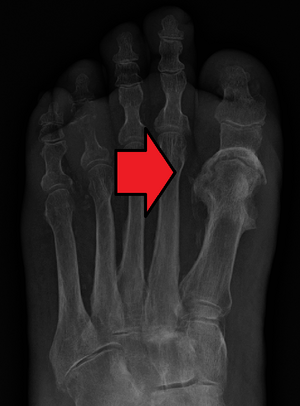Osteomyelitis
| Osteomyelitis | |
|---|---|
 |
|
| Osteomyelitis of the 1st toe | |
| Classification and external resources | |
| Specialty | Infectious disease, orthopedics |
| ICD-10 | M86 |
| ICD-9-CM | 730 |
| DiseasesDB | 9367 |
| MedlinePlus | 000437 |
| eMedicine | ped/1677 |
| Patient UK | Osteomyelitis |
| MeSH | D010019 |
Osteomyelitis (OM) is infection and inflammation of the bone. It can be usefully subclassified on the basis of the causative organism (pyogenic bacteria or mycobacteria) and the route, duration and anatomic location of the infection. Osteomyelitis usually begins as an acute infection, but it may evolve into a chronic condition. The word is from Greek words ὀστέον osteon, meaning bone, μυελό- myelo- meaning marrow, and -ῖτις -itis meaning inflammation.
The definition of OM is broad, and encompasses a wide variety of conditions. Traditionally, the length of time the infection has been present and whether there is suppuration (pus formation) or sclerosis (increased density of bone) is used to arbitrarily classify OM. Chronic OM is often defined as OM that has been present for more than one month. In reality, there are no distinct subtypes; instead there is a spectrum of pathologic features that reflect balance between the type and severity of the cause of the inflammation, the immune system and local and systemic predisposing factors.
OM can also be typed according to the area of the skeleton in which it is present. For example, osteomyelitis of the jaws is different in several respects from osteomyelitis present in a long bone. Vertebral osteomyelitis is another possible presentation.
In children, the long bones are usually affected. In adults, the vertebrae and the pelvis are most commonly affected.
Acute osteomyelitis almost invariably occurs in children. When adults are affected, it may be because of compromised host resistance due to debilitation, intravenous drug abuse, infectious root-canaled teeth, or other disease or drugs (e.g., immunosuppressive therapy).
...
Wikipedia
